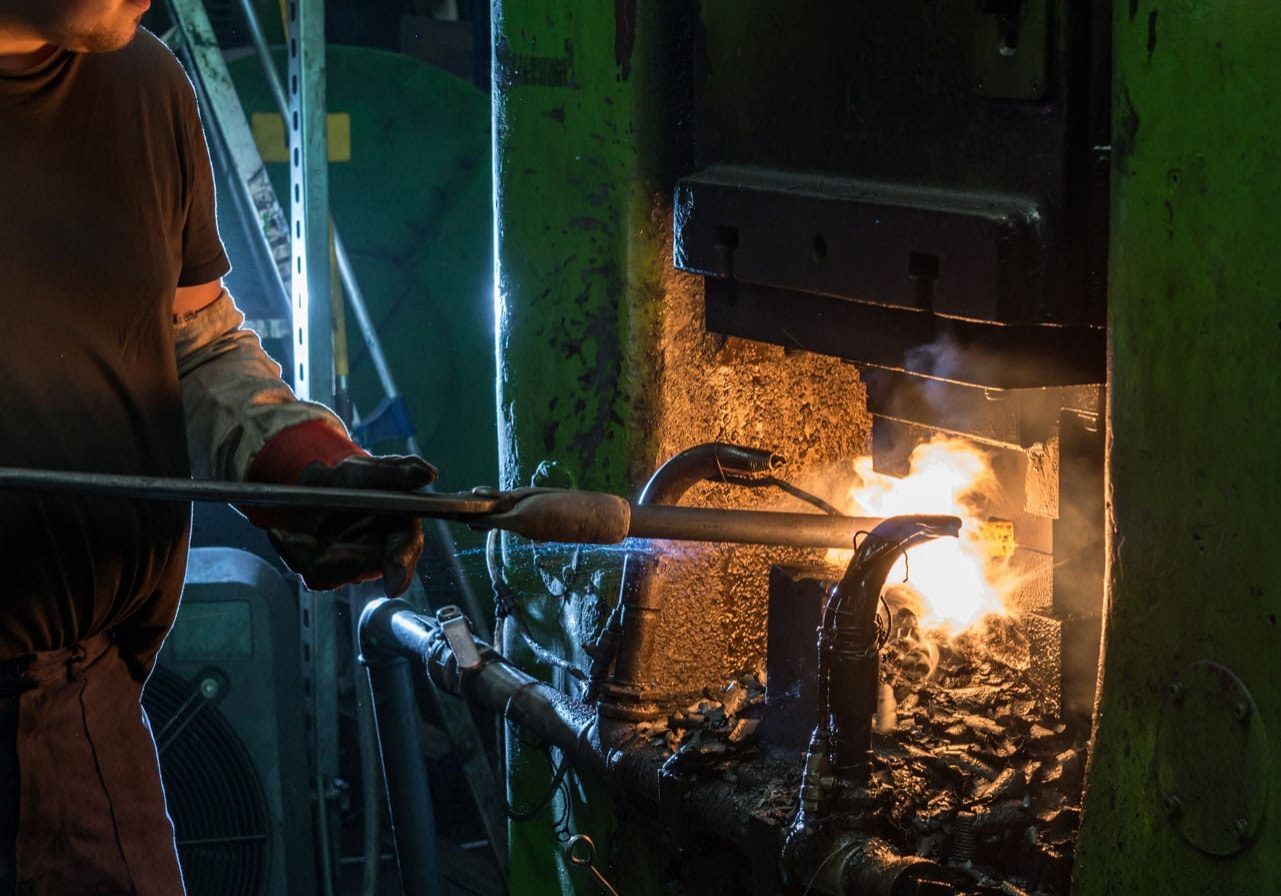Forging is a process that involves the reshaping of material into a required design and is carried out in many ways. Put simply forging is when a preheated metal is formed into the desired shape by heating and hammering the piece. The blows are usually delivered by a die or hammer.
There are many different types of forging; often classified by the temperature at which the process is performed, hot or cold forging and how the process if carried out.
The History of Forging
Forging is one of the oldest known metalworking processes. The earliest evidence of forging dates back to at least 4000 BC, when humans began to use fire to heat metal and shape it into tools and weapons.
The first forging techniques were very simple. Metal was heated in a fire and then hammered into shape with a rock or other tool. As forging techniques evolved, more sophisticated tools were developed, such as the anvil and the hammer. These tools allowed blacksmiths to create more complex shapes and objects.
Forging continued to evolve over the centuries, and by the Middle Ages, it was a well-established industry. Blacksmiths were found in every town and village, and they produced a wide variety of goods, including tools, weapons, and household items.
The Industrial Revolution brought about further changes in the forging industry. New machines were developed that allowed blacksmiths to produce goods more quickly and efficiently. Forging also became a more specialized industry, with different blacksmiths specializing in different types of goods.
Today, forging is still a major industry, and it is used to produce a wide variety of products, including tools, machine parts, and automotive parts. The basic principles of forging have remained the same over the centuries, but the tools and techniques have evolved to meet the needs of modern industry.
In the heart of the Black Country, forging is still a thriving industry. The Black Country is known for its rich history of metalworking, and it is home to many skilled blacksmiths who continue to practice the art of forging.

Various Types of Forging
There are many types of forging; the most common ones are hand, drop and upset forging.
Hand Forging
Hand forging, also known as blacksmithing, is the simplest form of forging. It is a traditional metalworking process that uses heat and force to shape metal into the desired form.
At B.B. Price, hand forging is a skilled and specialized process that is performed by experienced blacksmiths. The blacksmiths use a variety of tools, including a forge, a hammer, and an anvil, to heat and shape the metal.
The first step in hand forging is to heat the metal to a high temperature. This is done in a forge, which is a firebox that is used to heat metal. The metal is heated until it is red hot, which makes it soft and pliable.
Once the metal is heated, the blacksmith uses a hammer to shape it into the desired form. The blacksmith strikes the metal with the hammer, using different techniques to create the desired shape. The anvil is used to support the metal and to help the blacksmith shape it.
Hand forging is a slow and labor-intensive process, but it allows the blacksmith to create high-quality products with a unique look and feel. B.B. Price is proud to offer hand forging services to their customers, and they are confident that their blacksmiths can create the perfect product for your needs.
Drop Forging
Drop forging is a metalworking process that is used to create strong and durable parts. It is a versatile process that can be used to create a wide variety of products, including tools, machine parts, and automotive components.
At B.B. Price, drop forging is performed by a team of experienced and skilled engineers and blacksmiths. The process begins with heating the metal to a high temperature. This softens the metal and makes it easier to shape.
Once the metal is heated, it is placed in a die. The die is the shape that the metal will be forged into. A hammer is then lifted and dropped onto the metal, repeatedly, until the metal takes the shape of the die.
The repeated blows of the hammer force the metal to flow into the shape of the die. This process creates a strong and durable part with a smooth, uniform finish.
The metal is then cooled, which solidifies the new shape. The part is then inspected to ensure that it meets the required specifications.
B.B. Price is a leading provider of drop forging services. They have a long history of experience in the industry and are committed to providing their customers with the highest quality products and services.
Upset Forging
Upset forging is a metalworking process that is used to increase the cross-sectional area of a metal bar. It is a versatile process that can be used to create a wide variety of products, including tools, machine parts, and automotive components.
At B.B. Price, upset forging is performed by a team of experienced and skilled engineers and blacksmiths. The process begins with heating the metal bar to a high temperature. This softens the metal and makes it easier to shape.
Once the metal bar is heated, it is placed in a die. The die is the shape that the metal will be forged into. A press is then used to apply pressure to the end of the bar. This pressure forces the end of the bar into the die, forcing it into the shape of the mold.
The pressure of the press forces the metal to flow into the shape of the die. This process creates a strong and durable part with a smooth, uniform finish.
The metal is then cooled, which solidifies the new shape. The part is then inspected to ensure that it meets the required specifications.
B.B. Price is a leading provider of upset forging services. They have a long history of experience in the industry and are committed to providing their customers with the highest quality products and services.
The History of B.B. Price
B.B. Price was founded in 1875 by a gentleman called Joseph Price (Joseph was the great-grandfather of the current directors), starting off in the nail-making trade, using a simple forge in the outhouse of the family home. In the 1940s the business started supplying galvanized steelwork for overhead lines and telecommunications which still represents most of the company’s production to this current day.
For further information on any of our processes, products or sectors, why not get in touch with our team today. You can give us a call or complete our contact form online.
